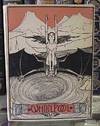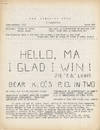

National Geographic Society 1888-1988
by Eberhard Faber
- Used
- near fine
- Condition
- Near fine
- Seller
-
Silver Spring, Maryland, United States
3 Copies Available from This Seller
(You can add more at checkout.)
Item Price
£20.23£15.17
Payment Methods Accepted
About This Item
Wilkes-Barre, PA: Eberhard Faber, 1988. MONGOL 482 Number 2. Collectible Pencil. Near fine. Approximately 7.5 inches long, unused. High in Fiber! A collectable is any object regarded as being of interest to a collector (not necessarily monetarily valuable or antique). Another important field of collecting that is also big business is memorabilia, which includes collectables related to a person, organization, event or media, including T-shirts, posters, and numerous other collectables marketed to fans; but also includes ephemera from historical, media, or entertainment events, items that were meant to be thrown away but were saved by fans and accumulated by collectors. There are numerous types of collectables and terms to denote those types. An antique is a collectable that is old. A curio is a small, usually fascinating or unusual item sought after by collectors. The urge to collect unusual and fascinating objects is primeval and not limited to humans. The Renaissance Cabinet of Curiosities was an antecedent both of modern museums and modern collecting. The earliest manufactured collectables were included as incentives with other products, such as cigarette cards in packs of cigarettes. Popular items developed a secondary market and sometimes became the subject of "collectable crazes". Eventually many collectable items came to be sold separately, instead of being used as marketing tools to increase the appeal of other products. Enthusiasts will often try to assemble a complete set of the available variations. Early versions of a product, manufactured in smaller quantities before its popularity as a collectable developed, sometimes command premiums on the secondary market. John Eberhard Faber (sometimes Johann Eberhard Faber) (December 6, 1822 - March 2, 1879), was a German-born American manufacturer of pencils in New York and the first person to establish a large scale pencil factory in the U.S.. In 1861, he opened the first lead pencil factory along the East River, between 41st and 43rd Streets, New York City. The factory was established under the name of Eberhard Faber. Leonard E. Read (1898-1983) in his 1958 Essay "I, Pencil" detailed the economic 'Free Market' benefit to the world economy of a 'Mongol 482' Eberhard Faber pencil.
A pencil is a writing implement or art medium constructed of a narrow, solid pigment core inside a protective casing which prevents the core from being broken or leaving marks on the user's hand during use.
Pencils create marks by physical abrasion, leaving behind a trail of solid core material that adheres to a sheet of paper or other surface. They are distinct from pens, which instead disperse a trail of liquid or gel ink that stains the light colour of the paper.
Most pencil cores are made of graphite mixed with a clay binder which leaves grey or black marks that can be easily erased. Graphite pencils are used for both writing and drawing and result in durable markings: though writing is easily removable with an eraser, it is otherwise resistant to moisture, most chemicals, ultraviolet radiation, and natural aging. Other types of pencil core are less widely used, such as charcoal pencils, which are mainly used by artists for drawing and sketching. Colored pencils are sometimes used by teachers or editors to correct submitted texts, but are typically regarded as art supplies, especially those with waxy core binders that tend to smear on paper instead of erasing. Grease pencils have a softer, crayon-like waxy core that can leave marks on smooth surfaces such as glass or porcelain. The most common type of pencil casing is of thin wood, usually hexagonal in section but sometimes cylindrical, permanently bonded to the core. Similar permanent casings may be constructed of other materials such as plastic or paper. To use the pencil, the casing must be carved or peeled off to expose the working end of the core as a sharp point.
The meaning of "graphite writing implement" apparently evolved late in the 16th century. Prior to 1565 (some sources say as early as 1500), a large deposit of graphite was discovered on the approach to Grey Knotts from the hamlet of Seathwaite in Borrowdale parish, Cumbria, England. This particular deposit of graphite was extremely pure and solid, and it could easily be sawn into sticks. This remains the only large-scale deposit of graphite ever found in this solid form. Chemistry was in its infancy and the substance was thought to be a form of lead. Consequently, it was called plumbago (Latin for "lead ore"). Many people have the misconception that the graphite in the pencil is lead, and the black core of pencils is still referred to as lead, even though it never contained the element lead. The words for pencil in German (Bleistift), Irish (Peann Luaidhe), Arabic (qalam ra ), and other languages literally mean lead pen. The value of graphite was soon realized to be enormous, mainly because it could be used to line the molds for cannonballs, and the mines were taken over by the Crown and guarded. When sufficient stores of graphite had been accumulated, the mines were flooded to prevent theft until more was required. Graphite had to be smuggled out for use in pencils. Because graphite is soft, it requires some form of encasement. Graphite sticks were initially wrapped in string or sheepskin for stability. The news of the usefulness of these early pencils spread far and wide, attracting the attention of artists all over the known world. England continued to enjoy a monopoly on the production of pencils until a method of reconstituting the graphite powder was found. The distinctively square English pencils continued to be made with sticks cut from natural graphite into the 1860s. The town of Keswick, near the original findings of block graphite, still manufactures pencils, the factory also being the location of the Cumberland Pencil Museum. The first attempt to manufacture graphite sticks from powdered graphite was in Nuremberg, Germany, in 1662. It used a mixture of graphite, sulphur, and antimony.
Residual graphite from a pencil stick is not poisonous, and graphite is harmless if consumed. Around 1560, an Italian couple named Simonio and Lyndiana Bernacotti made what are likely the first blueprints for the modern, wood-encased carpentry pencil. Their version was a flat, oval, more compact type of pencil. Their concept involved the hollowing out of a stick of juniper wood. Shortly thereafter, a superior technique was discovered: two wooden halves were carved, a graphite stick inserted, and the halves then glued together-essentially the same method in use to this day.
Reviews
(Log in or Create an Account first!)
Details
- Bookseller
- Ground Zero Books
(US)
- Bookseller's Inventory #
- 72731
- Title
- National Geographic Society 1888-1988
- Author
- Eberhard Faber
- Format/Binding
- Collectible Pencil
- Book Condition
- Used - Near fine
- Quantity Available
- 3
- Edition
- MONGOL 482 Number 2
- Publisher
- Eberhard Faber
- Place of Publication
- Wilkes-Barre, PA
- Date Published
- 1988
- Keywords
- National Geographic Society, Centennial, Memento, Collectible, Curio, Eberhard Faber, Mongol 482, Pencil, Writing Implement, Graphite, Memorbilia, Wood Products, Commemorative
Terms of Sale
Ground Zero Books
Books are offered subject to prior sale. Satisfaction guaranteed. If you notify us within 7 days that you are not satisfied with your purchase, we will refund your purchase price when you return the item in the condition in which it was sold.
About the Seller
Ground Zero Books
Biblio member since 2005
Silver Spring, Maryland
About Ground Zero Books
Founded and operated by trained historians, Ground Zero Books, Ltd., has for over 30 years served scholars, collectors, universities, and all who are interested in military and political history.
Much of our diverse stock is not yet listed on line. If you can't locate the book or other item that you want, please contact us. We may well have it in stock. We welcome your want lists, and encourage you to send them to us.
Much of our diverse stock is not yet listed on line. If you can't locate the book or other item that you want, please contact us. We may well have it in stock. We welcome your want lists, and encourage you to send them to us.
Glossary
Some terminology that may be used in this description includes:
- Fine
- A book in fine condition exhibits no flaws. A fine condition book closely approaches As New condition, but may lack the...
- New
- A new book is a book previously not circulated to a buyer. Although a new book is typically free of any faults or defects, "new"...
- Leaves
- Very generally, "leaves" refers to the pages of a book, as in the common phrase, "loose-leaf pages." A leaf is a single sheet...

